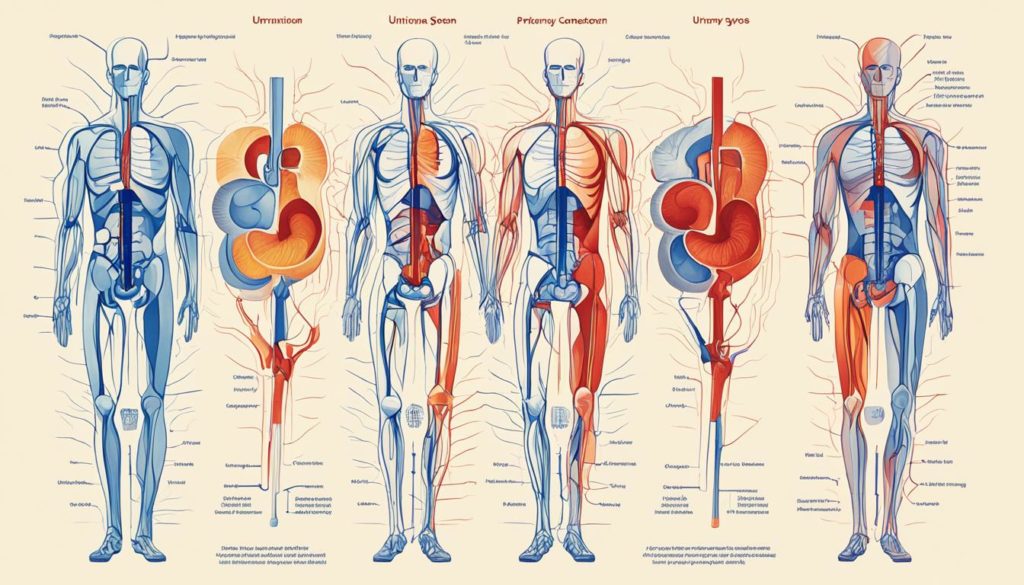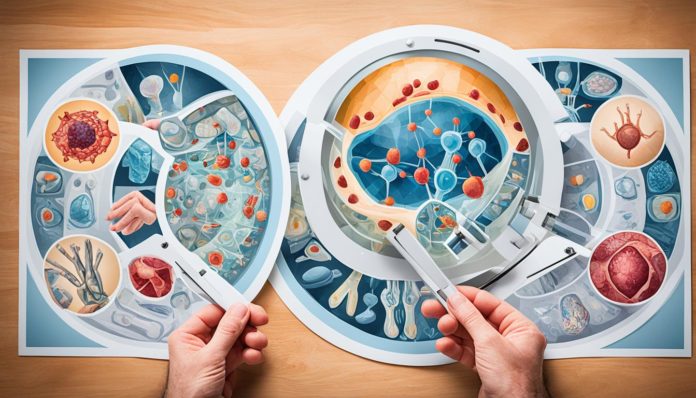Did you know that nearly 80% of men with prostate cancer find out when it’s still in the gland? This fact is crucial for understanding treatment choices early on. Choosing a treatment can be hard, considering factors like how old you are, your health, and your way of life.
There are many prostate cancer treatments, like watching it closely, surgery, radiation, and new methods. Each treatment affects your life and healing in its own way. It’s vital for each patient to get care that fits them, guided by their doctors.
It’s important to keep up with new treatments for prostate cancer. Support groups, like those the American Cancer Society offers, can help you choose the best treatment. Making this choice means looking at all the info and tailoring the care to suit you.
Key Takeaways
- 80% of prostate cancers are detected early when confined to the prostate gland.
- Factors like age, health, and lifestyle are crucial in treatment decisions.
- Options range from active surveillance to advanced surgical and radiation therapies.
- Personalized care is paramount for effective treatment and recovery.
- Support programs like those from the American Cancer Society can aid decision-making.
Understanding Prostate Cancer
Prostate cancer starts in the prostate gland with cells growing out of control. Knowing about this disease is essential for your health decisions. Early-stage cancer is often within the prostate itself, making it easier to handle.
What is Prostate Cancer?
This cancer occurs in the prostate, a gland shaped like a walnut that makes seminal fluid. Detecting it early is crucial for effective treatment. Often, there are no clear symptoms at first, so being watchful is important.
Symptoms and Early Detection
Spotting symptoms of prostate cancer early is key to getting ahead of the disease. Common signs include:
- Difficulty urinating
- Nighttime frequent urination
- Weak or interrupted urine flow
It’s important to catch prostate cancer early, so regular checks are advised, especially after turning 50. Recognizing these symptoms helps with quick action and health management.

Diagnosis and Staging
Diagnosing prostate cancer involves several tests. Important ones include:
- PSA blood test
- Digital Rectal Exam (DRE)
- Biopsy
These tests figure out the cancer’s stage, key for planning treatment. Understanding the stage helps pick the right treatment, improving chances of success.
Factors to Consider When Choosing a Treatment
Choosing the right path for prostate cancer treatment is complex. It must be tailored to the patient’s needs. These factors help in making the best prostate cancer management plan.
Age and General Health
The patient’s age and health play a key role in selecting a treatment. Younger, healthier patients might opt for aggressive methods to remove the cancer. On the other hand, older patients or those with other health issues might choose less harsh treatments.
Options like active surveillance are considered by some. Watchful waiting is another approach for them.

Cancer Stage and Grade
The cancer’s stage and grade show how aggressive it is and how much it has spread. Early-stage, low-grade cancers might only need monitoring. But more severe cancers require a detailed treatment approach.
This can include surgery, radiation, or hormone therapy.
Personal Preferences and Lifestyle
Choosing a treatment also involves the patient’s lifestyle and personal choices. It’s important to consider how treatments align with daily life and side effects. The goal is to find a treatment that matches the patient’s life goals and values.
Prostate Cancer Treatment Choices
Men with prostate cancer can choose from many treatments. This includes both surgery options and non-surgical methods. What they choose depends on how aggressive the cancer is and their personal goals.
The following table provides a detailed overview of various prostate cancer treatment choices and their potential outcomes:
| Treatment Option | Description | Pros | Cons |
|---|---|---|---|
| Active Surveillance | Monitoring the cancer closely and opting for treatment if it shows signs of progression. |
|
|
| Radical Prostatectomy | Surgical removal of the entire prostate gland. |
|
|
| External Beam Radiation Therapy (EBRT) | Targeted radiation to kill cancer cells. |
|
|
| Hormone Therapy | Reducing androgen levels to slow cancer growth. |
|
|
There are unique benefits and challenges with each treatment. It’s vital for patients to look at all options, both surgical and non-surgical. Talking with health care providers about advanced treatments is key. This will help make choices that fit their needs and preferences.
Active Surveillance and Watchful Waiting
Active surveillance and watchful waiting offer different paths for managing prostate cancer. They suit specific patient needs versus immediate treatment. These strategies help patients make informed choices about their care.
What is Active Surveillance?
Active surveillance involves close monitoring of prostate cancer without immediate action. It’s selected for low-risk, early stages of cancer. Patients have regular check-ups, PSA tests, DREs, and sometimes biopsies to watch the cancer.
Its main goal is to monitor the cancer closely. Treatment starts only if the cancer grows. This lets patients delay or avoid side effects from harsher treatments.
Benefits and Risks of Watchful Waiting
Watchful waiting also aims to manage cancer with less monitoring. It’s chosen by those whose cancer is not aggressive, who have serious health issues, or are advanced in age. This approach might spare them from cancer’s impact within their lifetime.
Watchful waiting minimizes medical interventions and side effects. Yet, the downside is the cancer might progress unnoticed. It can also lead to worry about not treating the cancer.
| Aspect | Active Surveillance | Watchful Waiting |
|---|---|---|
| Target Group | Low-risk, early-stage cancer patients | Patients with serious health issues or advanced age |
| Monitoring Intensity | Frequent (PSA, DRE, biopsies) | Less frequent |
| Benefits | Delay/avoid side effects, timely intervention | Avoid treatment side effects, less medical intervention |
| Risks | Potential cancer progression, increased anxiety | Unnoticed cancer progression, anxiety |
Advanced Surgical Options for Prostate Cancer
When looking into advanced surgical treatments for prostate cancer, knowing the options is key. The choice often depends on the doctor’s skills, cancer stage, and what the patient wants.
Radical Prostatectomy
A radical prostatectomy removes the prostate and some tissue around it. It’s chosen when cancer hasn’t spread beyond the prostate. The aim is to take out all the cancer cells to lower the chance of it coming back.
This approach is effective but may lead to side effects. These can include incontinence or erectile dysfunction.
Minimally Invasive Surgery
Minimally invasive surgeries, like laparoscopic or robot-assisted ones, have big benefits. They mean less pain after surgery, short hospital stays, and fast recovery. Surgeons make small cuts and use precise tools.
This leads to fewer problems and more accuracy during surgery. Because of these benefits, many patients prefer minimally invasive prostate surgery.
Radiation Therapy Techniques
Two main techniques are used in prostate cancer radiation therapy: External Beam Radiation Therapy (EBRT) and brachytherapy. Each approach has its own benefits and things to think about. It’s important for patients and doctors to carefully consider these options.
External Beam Radiation Therapy (EBRT)
EBRT targets and destroys cancer cells with high-energy rays from outside the body. This method is precise, protecting healthy tissues near the cancer. It’s effective for various stages of prostate cancer. Plus, it can be tailored for different situations.
Patients getting EBRT go through treatments for several weeks. This makes EBRT a well-organized choice for fighting cancer.
Brachytherapy
Brachytherapy puts radioactive seeds right inside the prostate. It hits the cancer hard while sparing nearby tissues. The benefits include quicker treatment and faster recovery compared to EBRT. It’s especially good for treating early-stage prostate cancer, with fewer side effects.
Choosing the right therapy for prostate cancer involves looking at EBRT and brachytherapy. The decision depends on the cancer’s stage, the patient’s health, and doctor’s advice. Both treatments are effective and can lead to better outcomes for patients.
Hormone Therapy as a Prostate Cancer Treatment
Hormone therapy is key in fighting advanced prostate cancer. It aims to cut or block testosterone production. Testosterone can make prostate cancer cells grow. This treatment helps slow down or shrink the cancer, making patients’ outcomes better.
How Hormone Therapy Works
Hormone therapy targets testosterone production to fight prostate cancer. It uses several methods:
- Luteinizing hormone-releasing hormone (LH-RH) agonists reduce testosterone made by the testicles.
- Anti-androgens prevent testosterone from reaching prostate cells.
This way, hormone therapy is vital for treating hormone-sensitive and advanced prostate cancer. It’s especially useful when surgery or radiation isn’t enough alone.
Combination with Other Treatments
Hormone therapy is often combined with other treatments, known as combination therapy. This enhances the effectiveness. It’s usually paired with:
- Radiation therapy, to boost treatment effects and control.
- Surgery, to lower the risk of cancer coming back in advanced cases.
However, hormone therapy can cause side effects like osteoporosis and hot flashes. Addressing these is important in the treatment plan. Thus, managing advanced prostate cancer means using a comprehensive approach. It combines hormone therapy with other methods for the best outcomes.
Focal Therapies: Targeting the Tumor
Focal therapies are new treatments that focus on the tumor in the prostate. They aim to lessen side effects common with surgery or radiation. Cryotherapy and High-Intesity Focused Ultrasound (HIFU) are two promising types of focal therapy.
Cryotherapy
Cryotherapy kills cancer cells by freezing them. It’s good because it can be done more than once and usually has fewer bad effects, like incontinence and erectile dysfunction. But, we still need more research to fully trust its long-term success.
High-Intensity Focused Ultrasound (HIFU)
HIFU uses ultrasound waves to heat and kill cancer in the prostate. This method hopes to cut down on side effects seen with other treatments. It’s a choice for those avoiding surgery or radiation. Yet, its effectiveness over time still needs to be proven with more studies.
Both cryotherapy and HIFU offer men less invasive options for treating prostate cancer where it hasn’t spread. These methods try to find a balance between treating the cancer and keeping a good life quality. Ongoing research is vital to make these treatments reliable options in prostate cancer care.
| Focal Therapy | Pros | Cons |
|---|---|---|
| Cryotherapy |
|
|
| HIFU |
|
|
Emerging and Cutting-Edge Treatments
Medical technology is advancing fast, leading to new prostate cancer treatments. Two promising methods are proton beam therapy and immunotherapy. These are gaining attention in the research and clinical fields.
Proton Beam Therapy
Proton beam therapy uses protons, not X-rays, to target cancer. It targets tumors with precision, protecting healthy tissue around them. Research shows it could be especially beneficial for those with localized prostate cancer.
Immunotherapy
Immunotherapy empowers the immune system to fight cancer itself. It’s proving to help increase survival rates for advanced prostate cancer. Since it’s fairly new, discussing its benefits and risks with a doctor is vital. Patients might also consider joining clinical trials.
New treatments like proton beam therapy and immunotherapy are changing the prostate cancer battle. Patients should stay updated on these advancements. Getting involved in clinical research can help explore more options for treatment.
Managing Side Effects and Quality of Life
Treating side effects from prostate cancer is key for patients. It greatly affects life quality during and after treatment. It’s vital to talk openly with your healthcare team to get a full treatment plan.
Common Side Effects to Consider
Prostate cancer side effects differ for everyone. They often include:
- Incontinence: Trouble controlling urination.
- Erectile Dysfunction: Problems having or keeping an erection.
- Bowel Issues: Issues like diarrhea or bleeding when using the bathroom.
Supportive Care and Rehabilitation
Supportive care is vital in dealing with side effects and improving life quality. It includes different services and therapies, like:
- Physical Therapy: Aids in getting back strength and movement.
- Counseling: Offers emotional and mental support.
- Medical Management: Helps manage and reduce symptoms.
Rehab after prostate cancer treatment is essential. A good rehab program may include:
- Regular check-ins with your doctors.
- Doing physical activities as planned.
- Joining support groups and therapy sessions.
Conclusion
Choosing the right prostate cancer treatment is a tough path. Yet, making an informed choice is key for the best results. Each person’s health history, age, cancer stage, and preferences should drive the treatment plan. Knowing the options—from watching the cancer closely to undergoing surgery, radiation, hormone therapy, or new treatments like proton beam therapy and immunotherapy—lets patients choose wisely for their needs.
Handling side effects and keeping a good quality of life during treatment is also critical. Using supportive care and rehabilitation can help manage side effects and boost well-being. Treating prostate cancer is not only about fighting the disease. It’s also about keeping up the person’s physical, emotional, and mental health. Having ongoing talks with a caring health team makes sure patients get personalized support.
The path to overcoming prostate cancer underscores the need for customized care and steady support. With doctors, patients, and loved ones working together, managing the disease and recovering well is possible. The main aim is always to empower patients through their treatment. This approach aims to improve both their survival and quality of life.
FAQ
What are the best prostate cancer treatments?
The top treatments for prostate cancer depend on many things. These include the cancer’s stage and grade, and the patient’s age and health. Treatment options include watching the cancer closely, surgery, and radiation. Hormone therapy and new treatments like focal therapies are also used.
How is prostate cancer diagnosed and staged?
To diagnose prostate cancer, doctors use PSA tests, rectal exams, and biopsies. They might also use imaging tests. These tests help find out the cancer’s grade and stage.
What factors should I consider when choosing a prostate cancer treatment?
When picking a treatment, think about your age and health. Also consider the cancer’s stage and your views on side effects. Talking to doctors can help you choose wisely.
What is active surveillance in prostate cancer treatment?
Active surveillance means watching early or low-risk prostate cancer closely. It aims to delay or skip aggressive treatments. This involves regular doctor visits, PSA tests, and sometimes biopsies.
What are the benefits and risks of watchful waiting?
Watchful waiting avoids harsh treatment side effects. But, there’s a risk the cancer could get worse. Being okay with this uncertainty and staying monitored is key.
What surgical options are available for prostate cancer?
Surgical choices include removing the prostate gland. There’s also laparoscopic or robot-assisted surgery. These offer quicker healing and fewer complications.
What are the different types of radiation therapy for prostate cancer?
Radiation therapy types are EBRT and brachytherapy. EBRT aims high-energy rays from outside the body. Brachytherapy puts radioactive seeds inside the prostate.
How does hormone therapy work in treating prostate cancer?
Hormone therapy lowers or stops testosterone, slowing cancer growth. It’s often used with radiation or surgery, especially in advanced cases.
What are focal therapies and how do they work?
Focal therapies like cryotherapy and HIFU target just the tumor. Cryotherapy freezes cancer cells. HIFU destroys them with ultrasound. This avoids many side effects.
What are some emerging treatments for prostate cancer?
New treatments include proton beam therapy and immunotherapy. Proton therapy targets the tumor to spare nearby tissues. Immunotherapy fights cancer with the immune system. Researchers are studying these methods.
How can the side effects of prostate cancer treatments be managed?
Side effects can be handled with supportive care. This includes therapy, counseling, and medicines. Talking openly with doctors is crucial for tackling these issues.


